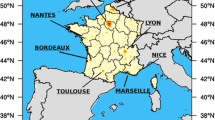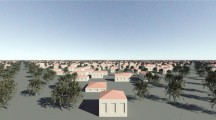Abstract
Urbanization modifies surface energy and water budgets, and has significant impacts on local and regional hydroclimate. In recent decades, a number of urban canopy models have been developed and implemented into the Weather Research and Forecasting (WRF) model to capture urban land-surface processes. Most of these models are inadequate due to the lack of realistic representation of urban hydrological processes. Here, we implement physically-based parametrizations of urban hydrological processes into the single layer urban canopy model in the WRF model. The new single-layer urban canopy model features the integration of, (1) anthropogenic latent heat, (2) urban irrigation, (3) evaporation from paved surfaces, and (4) the urban oasis effect. The new WRF–urban modelling system is evaluated against field measurements for four different cities; results show that the model performance is substantially improved as compared to the current schemes, especially for latent heat flux. In particular, to evaluate the performance of green roofs as an urban heat island mitigation strategy, we integrate in the urban canopy model a multilayer green roof system, enabled by the physical urban hydrological schemes. Simulations show that green roofs are capable of reducing surface temperature and sensible heat flux as well as enhancing building energy efficiency.












Similar content being viewed by others
References
Arnfield AJ (2003) Two decades of urban climate research: a review of turbulence, exchanges of energy and water, and the urban heat island. Int J Climatol 23:1–26
Bateni SM, Entekhabi D (2012) Relative efficiency of land surface energy balance components. Water Resour Res 48:W04510
Bergeron O, Strachan IB (2012) Wintertime radiation and energy budget along an urbanization gradient in Montreal, Canada. Int J Climatol 32:137–152
Chen F, Dudhia J (2001) Coupling an advanced land surface-hydrology model with the Penn State-NCAR MM5 modeling system. Part I: Model implementation and sensitivity. Mon Weather Rev 129:569–585
Chen F, Kusaka H, Tewari M, Bao JW, Hirakuchi H (2004) Utilizing the coupled WRF/LSM/Urban modeling system with detailed urban classification to simulate the urban heat island phenomena over the Greater Houston area. In: Fifth symposium on the urban environment, Vancouver, Canada, 23–27 August 2004
Chen F, Kusaka H, Bornstein R, Ching J, Grimmond CSB, Grossman-Clarke S, Loridan T, Manning KW, Martilli A, Miao SG, Sailor D, Salamanca FP, Taha H, Tewari M, Wang XM, Wyszogrodzki AA, Zhang CL (2011) The integrated WRF/urban modelling system: development, evaluation, and applications to urban environmental problems. Int J Climatol 31:273–288
Chow WT, Volo TJ, Vivoni ER, Jenerette GD, Ruddell BL (2014) Seasonal dynamics of a suburban energy balance in Phoenix, Arizona. Int J Climatol (published online). doi:10.1002/joc.3947
Diem JE, Brown DP (2003) Anthropogenic impacts on summer precipitation in central Arizona, USA. Prof Geogr 55:343–355
Dvorak B, Volder A (2010) Green roof vegetation for North American ecoregions: a literature review. Landsc Urban Plan 96:197–213
Field CB, Barros VR, Mach K, Mastrandrea M (2014) Climate change 2014: impacts, adaptation, and vulnerability. Working Group II Contribution to the IPCC 5th Assessment Report—Technical Summary, 76 pp
Goodwin NR, Coops NC, Tooke TR, Christen A, Voogt JA (2009) Characterizing urban surface cover and structure with airborne LIDAR technology. Can J Remote Sens 35:297–309
Grimmond CSB (1992) The suburban energy balance: methodological considerations and results for a mid-latitude west coast city under winter and spring conditions. Int J Climatol 12:481–497
Grimmond CSB, Oke TR (1986) Urban water balance: 2. Results from a suburb of Vancouver, British Columbia. Water Resour Res 22:1404–1412
Grimmond CSB, Blackett M, Best MJ, Barlow J, Baik JJ, Belcher SE, Bohnenstengel SI, Calmet I, Chen F, Dandou A, Fortuniak K, Gouvea ML, Hamdi R, Hendry M, Kawai T, Kawamoto Y, Kondo H, Krayenhoff ES, Lee SH, Loridan T, Martilli A, Masson V, Miao S, Oleson K, Pigeon G, Porson A, Ryu YH, Salamanca F, Shashua-Bar L, Steeneveld GJ, Tombrou M, Voogt J, Young D, Zhang N (2010) The international urban energy balance models comparison project: first results from Phase 1. J Appl Meteorol Clim 49:1268–1292
Grimmond CSB, Blackett M, Best MJ, Baik JJ, Belcher SE, Beringer J, Bohnenstengel SI, Calmet I, Chen F, Coutts A, Dandou A, Fortuniak K, Gouvea ML, Hamdi R, Hendry M, Kanda M, Kawai T, Kawamoto Y, Kondo H, Krayenhoff ES, Lee SH, Loridan T, Martilli A, Masson V, Miao S, Oleson K, Ooka R, Pigeon G, Porson A, Ryu YH, Salamanca F, Steeneveld GJ, Tombrou M, Voogt JA, Young DT, Zhang N (2011) Initial results from Phase 2 of the international urban energy balance model comparison. Int J Climatol 31:244–272
Hagishima A, Narita KI, Tanimoto J (2007) Field experiment on transpiration from isolated urban plants. Hydrol Process 21:1217–1222
Johnson TD, Belitz K (2012) A remote sensing approach for estimating the location and rate of urban irrigation in semi-arid climates. J Hydrol 414:86–98
Kusaka H, Kondo H, Kikegawa Y, Kimura F (2001) A simple single-layer urban canopy model for atmospheric models: comparison with multi-layer and slab models. Boundary-Layer Meteorol 101:329–358
Kusaka H, Chen F, Tewari M, Dudhia J, Gill DO, Duda MG, Wang W, Miya Y (2012a) Numerical simulation of Urban Heat Island effect by the WRF Model with 4-km grid increment: an inter-comparison study between the urban canopy model and slab model. J Meteorol Soc Jpn 90B:33–45
Kusaka H, Hara M, Takane Y (2012b) Urban climate projection by the WRF model at 3-km horizontal grid increment: dynamical downscaling and predicting heat stress in the 2070’s August for Tokyo, Osaka, and Nagoya metropolises. J Meteorol Soc Jpn 90B:47–63
Lantz N, Wang J (2010) Land cover information extraction using high resolution satellite data in Montreal. EPiCC Technical Report No. 5, 28 pp. http://www.epicc.ca/media-centre/presentations#TechDocs
Lee SH, Park SU (2008) A vegetated urban canopy model for meteorological and environmental modelling. Boundary-Layer Meteorol 126:73–102
Lemonsu A, Belair S, Mailhot J, Leroyer S (2010) Evaluation of the town energy balance model in cold and snowy conditions during the Montreal urban snow experiment 2005. J Appl Meteorol Clim 49:346–362
Loridan T, Grimmond CSB, Grossman-Clarke S, Chen F, Tewari M, Manning K, Martilli A, Kusaka H, Best M (2010) Trade-offs and responsiveness of the single-layer urban canopy parametrization in WRF: an offline evaluation using the MOSCEM optimization algorithm and field observations. Q J R Meteorol Soc 136:997–1019
Martilli A, Clappier A, Rotach MW (2002) An urban surface exchange parameterisation for mesoscale models. Boundary-Layer Meteorol 104:261–304
Masson V (2000) A physically-based scheme for the urban energy budget in atmospheric models. Boundary-Layer Meteorol 94:357–397
Mayer PW, Deoreo WBE (1999) Residential end uses of water. American Water Works Association, Denver, 310 pp
Miao S, Chen F (2014) Enhanced modeling of latent heat flux from urban surfaces in the Noah/single-layer urban canopy coupled model. Sci China Earth Sci 57:2408–2416
Miao S, Dou J, Chen F, Fan S (2012) Analysis of observations on the urban surface energy balance in Beijing. Sci China Earth Sci 55:1881–1890
Moriwaki R, Kanda M, Senoo H, Hagishima A, Kinouchi T (2008) Anthropogenic water vapor emissions in Tokyo. Water Resour Res 44:W11424
Myint SW, Gober P, Brazel A, Grossman-Clarke S, Weng QH (2011) Per-pixel vs. object-based classification of urban land cover extraction using high spatial resolution imagery. Remote Sens Environ 115:1145–1161
Oke TR (1979) Advectively-assisted evapotranspiration from irrigated urban vegetation. Boundary-Layer Meteorol 17:167–173
Oke TR (1988) The urban energy balance. Prog Phys Geog 12:471–508
Ramamurthy P, Bou-Zeid E (2014) Contribution of impervious surfaces to urban evaporation. Water Resour Res 50:2889–2902
Sailor DJ, Hart M (2006) An anthropogenic heating database for major US cities. In: Sixth symposium on the urban environment, Atlanta, Georgia, 28 January–3 February 2006
Sailor DJ, Lu L (2004) A top-down methodology for developing diurnal and seasonal anthropogenic heating profiles for urban areas. Atmos Environ 38:2737–2748
Sailor DJ, Brooks A, Hart M, Heiple S (2007) A bottom-up approach for estimating latent and sensible heat emissions from anthropogenic sources. In: Seventh symposium on the urban environment, San Diego, California, 10–13 September 2007
Salamanca F, Krpo A, Martilli A, Clappier A (2010) A new building energy model coupled with an urban canopy parameterization for urban climate simulations-part I. formulation, verification, and sensitivity analysis of the model. Theor Appl Climatol 99:331–344
Salamanca F, Martilli A, Tewari M, Chen F (2011) A study of the urban boundary layer using different urban parameterizations and high-resolution urban canopy parameters with WRF. J Appl Meteorol Clim 50:1107–1128
Santamouris M (2014) Cooling the cities—a review of reflective and green roof mitigation technologies to fight heat island and improve comfort in urban environment. Sol Energy 103:682–703
Senay GB, Budde M, Verdin JP, Melesse AM (2007) A coupled remote sensing and simplified surface energy balance approach to estimate actual evapotranspiration from irrigated fields. Sensors 7:979–1000
Song J, Wang ZH (2014) Interfacing the urban land-atmosphere system through coupled urban canopy and atmospheric models. Boundary-Layer Meteorol (in press). doi:10.1007/s10546-014-9980-9
Sun T, Bou-Zeid E, Wang ZH, Zerba E, Ni GH (2013) Hydrological determinants of green roof performance via a vertically-resolved model for heat and water transport. Build Environ 60:211–224
Tooke TR, Coops NC, Goodwin NR, Voogt JA (2009) Extracting urban vegetation characteristics using spectral mixture analysis and decision tree classifications. Remote Sens Environ 113:398–407
United Nations (2012) World urbanization prospects: the 2011 revision. The United Nations’ Department of Economic and Social Affairs—Population Division, New York, 50 pp
van der Laan M, Tooke TR, Christen A, Coops N, Heyman E, Olchovski I (2011), Statistics on the built infrastructure at the Vancouver EPiCC experimental sites. EPiCC Technical Report No. 4, 30 pp. http://www.epicc.ca/media-centre/presentations/#TechDocs
Wang ZH (2014a) Monte Carlo simulations of radiative heat exchange in a street canyon with trees. Sol Energy 110:704–713
Wang ZH (2014b) A new perspective of urban-rural differences: the impact of soil water advection. Urban Clim 10:19–34
Wang ZH, Bou-Zeid E, Smith JA (2011a) A spatially-analytical scheme for surface temperatures and conductive heat fluxes in urban canopy models. Boundary-Layer Meteorol 138:171–193
Wang ZH, Bou-Zeid E, Au SK, Smith JA (2011b) Analyzing the sensitivity of WRF’s single-layer urban canopy model to parameter uncertainty using advanced Monte Carlo simulation. J Appl Meteorol Clim 50:1795–1814
Wang ZH, Bou-Zeid E, Smith JA (2013) A coupled energy transport and hydrological model for urban canopies evaluated using a wireless sensor network. Q J R Meteorol Soc 139:1643–1657
Wang ZX, Jiang YH, Li J, Liu WD, Wang Q (2009) On the measurement of urban boundary layer radiation of the meteorological tower in Beijing (in Chinese). Plateau Meteorol 28:20–27
Yang J, Wang ZH (2014) Parameterization and sensitivity of urban hydrological models: application to green roof systems. Build Environ 75:250–263
Yang J, Wang ZH, Lee TW (2013) Relative efficiency of surface energy partitioning over different land covers. Brit J Environ Clim Change 3:86–102
Zhang CL, Chen F, Miao SG, Li QC, Xia XA, Xuan CY (2009) Impacts of urban expansion and future green planting on summer precipitation in the Beijing metropolitan area. J Geophys Res Atmos 114:D02116
Acknowledgments
This work is supported by the National Science Foundation (NSF) under grant number CBET-1435881. Partial financial supports for ZHW and JY from the Central Arizona-Phoenix Long-Term Ecological Research project under NSF grant CAP3: BCS-1026865, and the Summer Visitor’s program by the National Center for Atmospheric Research are gratefully acknowledged. SM is supported by the National Natural Science Foundation of China under grant No. 41175015.
Author information
Authors and Affiliations
Corresponding author
Rights and permissions
About this article
Cite this article
Yang, J., Wang, ZH., Chen, F. et al. Enhancing Hydrologic Modelling in the Coupled Weather Research and Forecasting–Urban Modelling System. Boundary-Layer Meteorol 155, 87–109 (2015). https://doi.org/10.1007/s10546-014-9991-6
Received:
Accepted:
Published:
Issue Date:
DOI: https://doi.org/10.1007/s10546-014-9991-6




